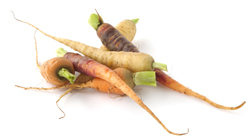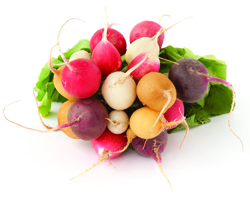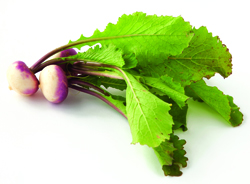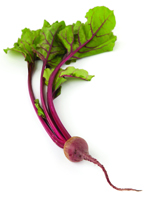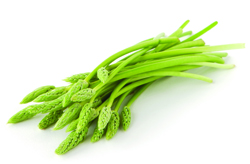Tutored tasting: heritage
Heritage varieties are the older or heirloom vegetables. Each variety has its own history and chefs use the vegetable's ‘oddness' (too knobbly, strange colours) to enhance the look and flavour of a dish.
Foraging also continues to be a popular past-time, and the likes of wild asparagus and dandelion leaves can add a homely or unusual element.
Though heritage varieties are often more expensive than cultivated varieties, they are definitely a worthy addition to dishes as they add interest, colour and flavour that commercial vegetables simply cannot.
As part of our tutored tasting series with New Covent Garden Market, Marcus Bunney from supplier J Connell guides us through a selection of heritage and foraged varieties supplied by wholesaler the French Garden, while head chef Robert Malyon of La Brasserie shares his ideas for using these unusual ingredients.
SAND CARROTS (CAROTTES DES SABLES)
Properties These carrots are grown in sandy soil composed of river silt in a tiny part of coastal Normandy. The area benefits from a mild maritime climate, sea breezes and salt spray, and the carrots are fertilised with local seaweed. All these factors combine to produce carrots with the taste of the sea, a deep orange colour, a melting texture and delicate taste.
Notes Sand carrots are harvested according to the demands of the market, which ensures maximum freshness.
HERITAGE RADISH
Properties Heritage radishes are longer than cultivated varieties and tend to be hotter.
Usage Best when they are as fresh as possible, in salads or on their own as a garnish.
Notes The crop grows astonishingly quickly, speeding up as the weather warms, and by June they can take as little as 25 days from seed to harvest. Traditionally, radishes are harvested from St George's Day to Hallowe'en, but by using naturally cold-resistant varieties, the season can be stretched from mid-February to November.
TURNIPS (NAVETS)
Properties Le Navet is the yellow turnip in standard French, and it has an acquired taste. Just the white, bulbous taproot is used.
Usage When they are young and fresh in spring, the flavour is delicate and not as overpowering as it often is in autumn and winter. They can easily be eaten raw or used to accompany a meat dish: boil briefly then glaze in a sugar and butter mixture.
GOLDEN BEETROOT
Properties Golden beetroot has a more subtle flavour than the red variety, and its vibrant golden colour makes it a great garnish.
DANDELION (PISSENLIT)
Properties Pissenlit is the French name for dandelion, and it is named for its diuretic properties. This prolific herb, which is considered a weed, is edible in its entirety.
If left to grow naturally, Pissenlit has dark green leaves containing high amounts of iron. The leaves are sometimes forced and grown in the dark - much like rhubarb. Lack of light results in paler leaves due to lack of chlorophyll and, as a result, the leaves are less bitter.
Usage Great as a green in salads, but can also be blanched and wilted for pesto or as a pasta accompaniment.
Notes High in vitamins A and C, dandelion leaves contain more iron than spinach when chlorophyll is allowed to form.
WILD ASPARAGUS (GRASS)
Properties Wild asparagus has thinner and longer shoots than the cultivated variety, but otherwise it is very much similar to its commercially grown cousin - asparagus officianlis - albeit with a slightly more delicate taste.
Notes Refrigerate wild asparagus as soon as possible to prevent the spears from becoming stringy. It can also be blanched and frozen to preserve it.
WHAT THE CHEF SAID
Robert Malyon, head chef, La Brasserie, Kensington, London
Heritage varieties have a really intense flavour and I like the fact they are not all a uniform shape and size - they give dishes a really attractive, rustic look.
Sand carrots are so naturally tasty that we scrub them rather than peel them to preserve the flavour. We cook them in a little butter and water with a pinch of sugar. We use heritage carrots raw in salads or very lightly cooked so they retain their colour. Just one or two slices can really brighten up a plate.
We serve turnips aigre-doux, which is a French sweet and sour pickle. We boil white wine vinegar, bay leaf and peppercorns and, while it's still hot, pour it over thinly sliced turnips. You can do this with other vegetables too, such as radish or mushrooms. We serve the pickled turnip with salmon tartare.
Heritage radishes come in beautiful shades of purple, white and yellow. We use them in a salad with mixed leaves, green beans and tiger prawns cooked in chilli, garlic and white wine. It's a really popular summer dish.
The beetroot we roast and serve as a garnish and we also purée it and serve it with medallions of salmon and braised lentils.
Wild asparagus is fragile and delicate and needs very little cooking. I like to sauté it in butter and serve it simply with lemon and a little seasoning.



